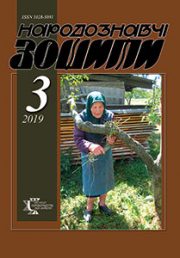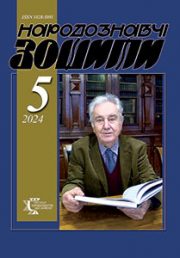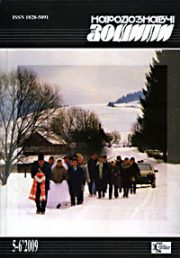The Ethnology Notebooks. 2019, 2 (146), 293—302
UDK 398.33: 264-94(477)
DOI https://doi.org/10.15407/nz2019.02.293
DYAKIV Volodymyr
ORCID ID: https://orcid.org/0000-0002-9513-4364
filol. s., Senior Researcher
at the Ethnology Institute
of the National Academy of Sciences of Ukraine,
15, Svobody Avenue, 79000, Lviv, Ukraine
Contacts: e-mail: V. Dyakiv@nas.gov.ua
Abstract. Introduction. The pre-Christian traditions and customs associated with the winter cycle of traditional calendar ritualism have been best preserved allowing us to trace the process of their transformation up to now.
Problem Statement. We will try to analyze the background of pre-New Year and pre-Christmas period, a sort of its prelude, the beginnings of which is traced, according to our observation, from the autumn feast of St. Simeon. Thus, using this feast as an example, we will analyze the development of peculiar folk religiosity in traditional calendar ritualism of Ukrainians against the background of pre-New Year and pre-Christmas period.
Purpose. The objective of this work is to distinguish folk and religious beliefs specific to the traditional early winter period (beginning of a new economic year etc.) and define a traditional basis and innovative changes as well as peculiarity of the development of narrative and structural components, elements and details.
Methods. The article relies mainly on comparative-typological and historical-cultural approaches as well as elements of structural-typological and geographical methods of ethnology and folklore studies.
Results. A specific development of peculiar folk religiosity in traditional calendar ritualism of Ukrainians is observed against the background of pre-New Year and pre-Christmas period starting from the St. Simeon’s feast. This opinion is supported by folk and religious beliefs specific to the traditional early winter period, in particular, the ones related to weather or other lore for the next harvest year, prediction (prophesying) of prosperity or bad harvest.
Conclusion. A peculiar development of certain folk and religious components can be distinctly traced in traditional folk and religious beliefs of Ukrainians typical of the early winter period. Later, Christianity left its mark on these beliefs. Christian beliefs were combined with the previous ones, having enhanced and complemented them with their characters, themes and plots. These folk and religious beliefs have been preserved in the spiritual traditional culture of Ukrainians for the most part quite fragmentarily, obviously, under a pernicious influence of political circumstances of warlike and atheistic nature in the 20th century and, perhaps, have been also influenced by an inter-generational transmission and globalization phenomenon in general that can be observed up to now.
Keywords: folk religiosity, feast of saint Simeon, calendar rituality, tradition, beliefs, functioning.
Received 30.01.2019
REFERENCES
Petrushevych, A.S. (1866). All-Russian journal of church, family and folk holidays, household chores, omens and fortune telling. Lvov [in Russian].
Sumtsov, N.F. (1890). Cultural experience. Kіevskaja Starina (Vol. XXX, pp. 72—87) [in Russian].
Franko, I. (1898). Folk calendar. Etnohrafichnyj Zbirnyk (Vol. V, pp. 203—210) [in Ukrainian].
Zubrytskyi, M. (1900). Folk calendar. Folk customs and beliefs associated with days of the week and yearly holidays. Materialy do ukrains’ko-rus’koi etnolohii (Vol. 3, pp. 33—60) [in Ukrainian].
Shukhevych, V. (1904). Hutsulshchyna. Fourth part. XVII: Church rituals. Materyialy do ukrains’ko-rus’koi etnol’ogii (Vol. VII) [in Ukrainian].
Dykarev, М. (1905). Folk calendar of Valyki Uyezd (Borisovo Volost) in Voronezh region. In Materyialy do ukrains’ko-rus’koi etnol’ogii (Vol. VI, pp. 114—204) [in Ukrainian].
Hrushevskyi, M. (1993). History of Ukrainian literature: in 6 volumes. 9 books (Vol. 1). Kyiv [in Ukrainian].
Hrushevskyi, M. (1992). History of religious thought in Ukraine. Kyiv: Osvita [in Ukrainian].
Sosenko, К. (1928). Cultural and historical image of old Ukrainian holidays of Christmas and Malanka. Lviv [in Ukrainian].
Biletskyi, L. (1947). History of Ukrainian literature: in 2 volumes. (Vol. 1). Augsburg [in Ukrainian].
Voropai, О. (1958). Customs of our people. Ethnographic essay (Vol. 2, Part. 4). Munich: Ukrains’ke vydavnytstvo [in Ukrainian].
Onatskyi, Y. (1964). Semena. In Onatskyi Yevhen. Ukrainian small encyclopedia: in 8 volumes and 16 books (Vol. 13, p. 1715). Buenos Aires (Argentina) [in Ukrainian].
Kylymnyk, S. (1963). Autumn cycle. In Ukrainian year in folk customs within historical context: in 5 volumes (Vol. 5). Winnipeg; Toronto [in Ukrainian].
Kurochkin, О.V. (1978). New Year’s festivities of Ukrainians. Traditions and modern age. Kyiv [in Ukrainian].
Voitovych, V. (2002). Ukrainian mythology. Kyiv: Lybid’ [in Ukrainian].
Kutelmakh, К.М. (2006). Calendar ritualism as an ethnogenetic source. In Ethnogenesis and ethnic history of the people of the Ukrainian Carpathians: in 4 volumes (Vol. 5, pp. 473—557). Lviv: Institute of Ethnology of the National Academy of Sciences of Ukraine [in Ukrainian].
Kyrchiv, R. (2017). Preromantic and romantic folklore studies. In History of Ukrainian folklore studies (Vol. 1). Lviv [in Ukrainian].
Galko, I. (1862). Folk customs and rituals from the outskirts over Zbruch described by Ignatii Galko (Vol. 2). Lviv [in Russian].
Kozlovska, V. (1928). Page from the cults review. Sacred oak of Slavic pagans. In Pervisne hromadianstvo ta joho perezhytky na Ukraini (Issue 1, pp. 95—104) [in Ukrainian].
Krut, Yu.Z. (1973). Agrarian ritual poetry of Slavic people. Kyiv [in Ukrainian].
Hoshko, Y. H. (Ed.). (1983). Boikivshchyna: historical and ethnographic research. Kyiv: Naukova Dumka [in Ukrainian].
Mishchenko, М.О. (1995). Folk calendar. Kyiv: Veselka [in Ukrainian].
Boriak, О. (1997). Weaving in rituals and beliefs of Ukrainians (mid. 19Th – early 20 thcentury). Kyiv: NAS of Ukraine; Institute of Art Studies, Folklore Studies and Ethnology. M.T. Rilsky [in Ukrainian].
Moisei, А.А. (2010). Agrarian customs and rituals in folk calendar of the Eastern Romance people in Bukovyna. Chernivtsi: Druk-Art [in Ukrainian].
Kozholianko, О.H. (2014). Calendar holidays and rituals of Ukrainians in Bukovyna: semantics and symbols. Chernivtsi: Druk-Art [in Ukrainian].
Stishova, N.S. (2017). Ukrainian calendar holidays of autumn cycle. Kyiv [in Ukrainian].
Dobrovolskyi, V.N. (1901). Meaning of the folk holiday of the candle. Jetnograficheskoe Obozrhnіe. Izdanіe Jetnograficheskago Otdela Imperatorskago Obshhestva Ljubitelej Estestvoznanіja, Antropologіi i Jetnografіi, sostojashhago pri Moskovskom universitetе, 4, 35—51 [in Russian].
Chicherov, V.I. (1957). Winter period of Russian folk agrarian calendar of the 16—19th centuries. Moscow [in Russian].
Darkevych, V.P. (1961). Axe as a symbol of Perun in Old Russian paganism. Sovetskaja arheologija, 4, 95—100 [in Russian].
Rybakov, B.А. (1962). Calendar from the land of the Polans. Sovetskaja arheologija, 4, 66—89 [in Russian].
Rybakov, B.А. (1967). Key issues in the study of Slavic paganism. In Trudy VII mezhdunarodnogo kongressa antropologicheskih i jetnograficheskih nauk (Vol. VIII). Moscow [in Russian].
Veletskaya, N.N. (1968). New Year’s Rusalii. In Slavjane i Rus’ (pp. 394—400). Moscow [in Russian].
Bogatyrev, P.G. (1971). Issues of the theory of folk art. Moscow [in Russian].
Tokarev, S.A. (Ed.). (1973). Calendar customs and rituals in foreign European countries (19th — early 20th century). Moscow: Nauka [in Russian].
Veletskaya, N.N. (1978). Pagan symbols of archaic rituals. Moscow [in Russian].
Matveeva, N. (1995). Solstice: holidays, customs and traditions. In Church and folk Menologion. Kyiv: Ukrainskij centr duhovnoj kul’tury [in Russian].
Agapkina, Т.А., & Belova, О.V. (2009). St. Simeon’s Day. In Slavic antiquities: Ethno linguistic dictionary (Vol. 4, pp. 610—612). Moscow: Mezhdunarodnyye otnosheniya [in Russian].
National archival scientific collections of manuscripts and audio recordings of M.T. Rylsky Institute of Art Studies, Folklore and Ethnology of the National Academy of Sciences of Ukraine. F. 15—3. Od. save 239—246 [in Ukrainian].
State archive of Vinnytsia region. F. 595. Od. save 5. Arc. 1—118 [in Ukrainian].
Archive of the IN NANU (Archive of the Institute of Ethnology of the National Academy of Sciences of Ukraine). Materials of ethnographic expeditions from the Museum of Ethnography and Art Crafts of Academy of Sciences of the Ukrainian Soviet Socialist Republic, 1968 [in Ukrainian].
Archive of the IN NANU (Archive of the Institute of Ethnology of the National Academy of Sciences of Ukraine), Materials of ethnographic expeditions in Zakarpattia region from the Museum of Ethnography and Art Crafts of Academy of Sciences of the Ukrainian Soviet Socialist Republic, 1977 [in Ukrainian].
Shekeryk-Donykiv, Petro. (2009). A year in beliefs of Hutsuls. Selected works. Verkhovyna: Hutsul’schyna [in Ukrainian].
Kozholianko, О. (2015). September folk holidays in Bukovyna. The Ethnology Notebooks, 1 (121), 121—126 [in Ukrainian].
Radovych, R. (2012). Polish «Posvit» (Technological and cultural-genetic aspects). The Ethnology Notebooks, 5 (107), 799—817 [in Ukrainian].
Domanytskyi, V. (1912). Folk calendar in Rovno Uyezd, Volyn Guberniya. Recorded by Vasyl Domanytskyi. Materiialy do ukrains’koi etnol’ogii, 15, 62—89 [in Ukrainian].







